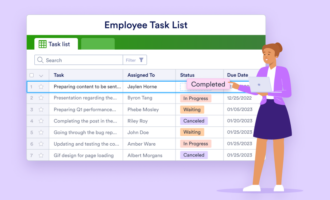Tips to improve cross-team collaboration
- Create a team charter
- Make time for team updates
- Be mindful of meeting frequency
- Use project management tools
- Centralize work requests
- Facilitate cross-team collaboration with technology
No matter your role, one of the best ways to ensure successful project management is by improving cross-team collaboration. Working across teams can be difficult, which is why many departments work within silos. Many teams struggle with transparent communication and getting “in sync” with other departments — especially if they’re part of a large company or work remotely.
There are several steps you can take to overcome these obstacles and achieve successful cross-team collaboration — and they don’t require expensive software or complicated methodologies. Read on for six cross-team collaboration tips.
1. Create a team charter
Before anything else, it’s critical all team members are on the same page. Create a document that details your team’s mission, objectives, and goals. Make sure to include each team member’s role and responsibilities, and include the main point of contact for each department.
Update this charter as you onboard new team members, when current team members receive promotions, and whenever objectives, goals, and key performance indicators (KPIs) change. And you don’t have to reinvent the wheel — you can use helpful Jotform PDF templates to begin creating your own team charter.
2. Make time for team updates
Quick daily huddles are a great way for employees to better understand what their teammates are actually doing. Daily huddles don’t need to be long — they can be brief, 15-minute meetings where teammates provide updates on project progress, review critical time-sensitive action items, reveal current obstacles, and share successes.
When everyone knows what’s going on, it opens the door for team members to lend a hand when a coworker is struggling with an urgent deadline or has too much on their plate. Or perhaps someone has special expertise or valuable insights to share for an upcoming project. Quick, informal meetings like this can encourage better communication and collaboration.
3. Be mindful of meeting frequency
Meeting regularly is necessary for collaborative work. At the same time, too many meetings can eat away at your employees’ ability to focus on the task at hand. Do what you can to limit the number of meetings team members attend, and try to make the meetings you do have as productive as possible (so you don’t hinder the collaborative process).
Before inviting someone to a meeting, ask yourself if it’s really necessary for them to attend. If they might find the meeting helpful (but it’s not necessary for them to actively participate), you can mark them as “optional” on the meeting invitation.
You can also create company-wide meeting-free time blocks to help your employees reach peak productivity. For example, you can add placeholders in your company calendar a couple of days a week for a two-hour window of time so everyone knows not to schedule meetings then. This way, all team members have guaranteed, uninterrupted pockets of time to focus and get important work done.
4. Use project management tools
You can also cut down on back-and-forth emails by using project management (PM) tools to track project progress and provide updates.
Some PM tools are complex; employees need training and reference guides to understand how they work. While those complicated resources may work for some companies, all you really need is a simple way to track progress and updates in a consolidated space.
Spreadsheets increase transparency and eliminate silos by making your team’s work as visible as possible, allowing anyone with access to see your goals, estimated deadlines, and priorities.
Jotform Tables is a simple yet robust solution that allows you to create powerful tables for nearly any use case, like project tracking, sprint planning, and managing daily task checklists.
You can share tables with teammates — so they can both stay informed and offer insight — and customize access settings to control which users can view or edit a table. Multiple teams can then access and view the table to stay in the loop, but you’ll maintain control over who has editing capabilities.
5. Centralize work requests
Certain departments — like marketing and creative — are bound to receive lots of project requests for tasks like creating event flyers and updating iconography. It’s easy to miss requests like this under a mountain of emails or overlook them in fast-moving team messaging platforms like Slack.
Consider creating a process for work requests, like an online ticketing system. With Jotform, for example, you can
- Customize your request form so your team has all the information they need when someone makes a request. You can work from fully customizable form templates or create your perfect form from scratch.
- Route all submissions through a department Slack channel, an email address, or another workplace tool through simple integrations so each request gets high visibility. You can customize who gets a notification for each work request form submission and what channels the notifications come through. You can also use forms as the basis for an approval workflow — and use Jotform Approvals to build one.
- Use the form response data (e.g., your work requests) to automatically create centralized databases. You can quickly gain insights into the kinds of requests your team receives and share reports with other teams and management at the drop of a hat.
6. Facilitate cross-team collaboration with technology
As you choose the platforms and applications that work best for your team, you may want to check whether or not those technologies can “speak to” or integrate with one another.
Platform automations and integrations can intuitively update your records, cutting down on your need to manually update them and saving everyone on your team valuable time.
As mentioned, Jotform integrates with more than a hundred applications spanning analytics, automation, data management, and payment systems. You can also facilitate the way forms move through your organization with the Jotform Mobile Forms app, which everyone can download to fill out, approve, and manage forms.
Cross-team collaboration is no easy feat. Managing one team is difficult on its own, much less working within multiple teams. But that doesn’t mean it’s impossible. By following these tips, you and your teams can keep each other informed, make the most of everyone’s strengths, and help one another when necessary.
Photo by Antoni Shkraba


























Send Comment: